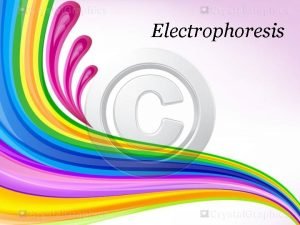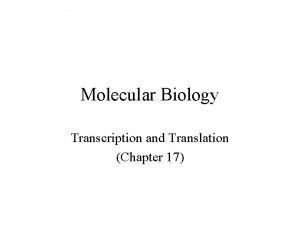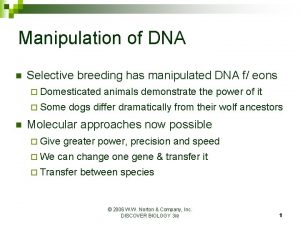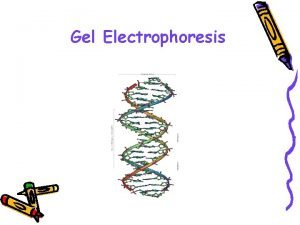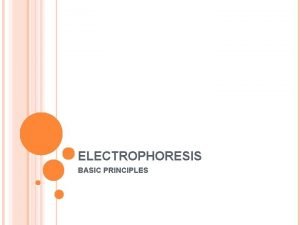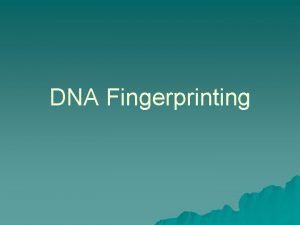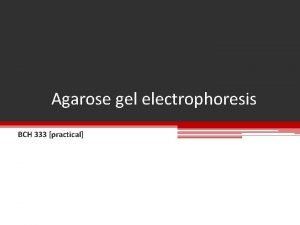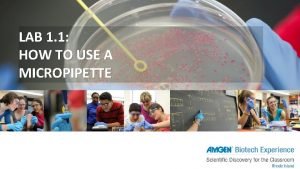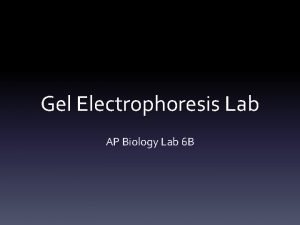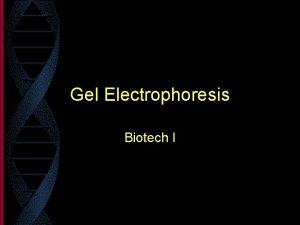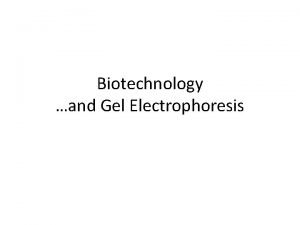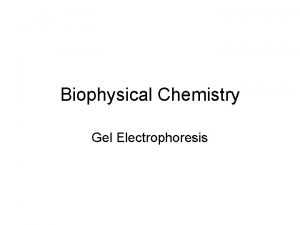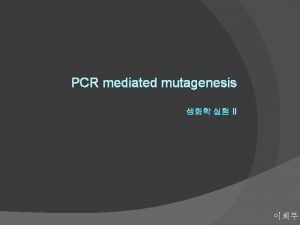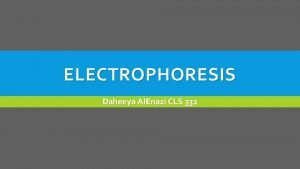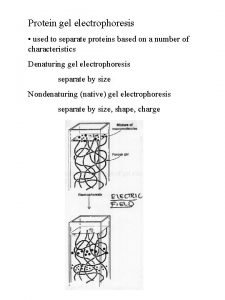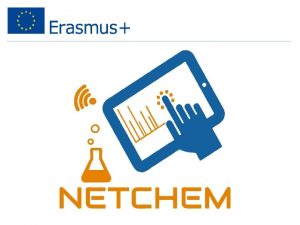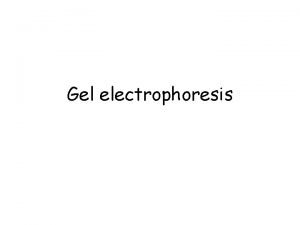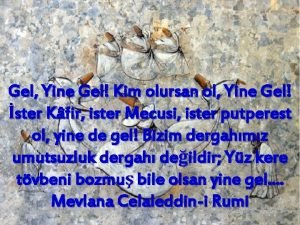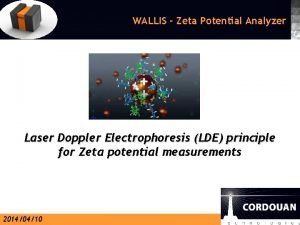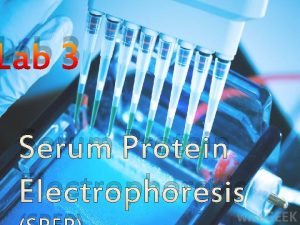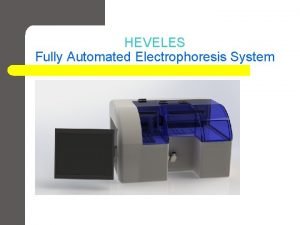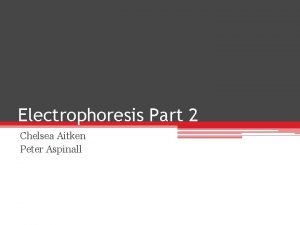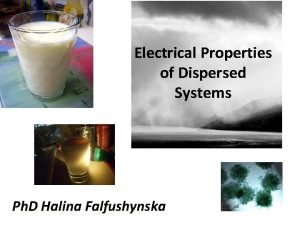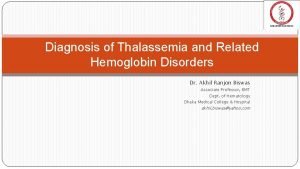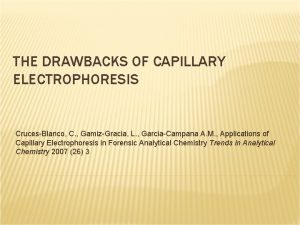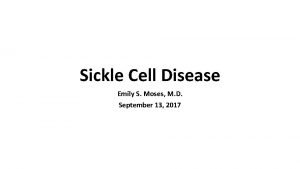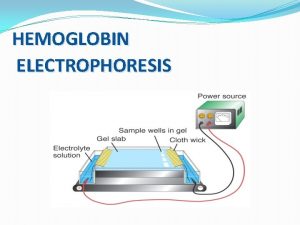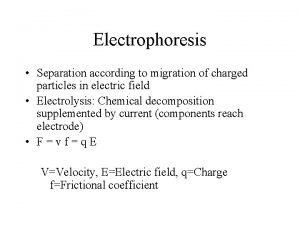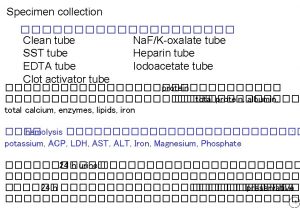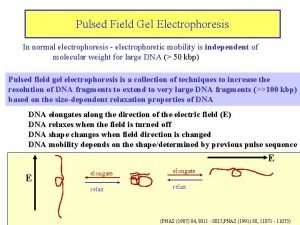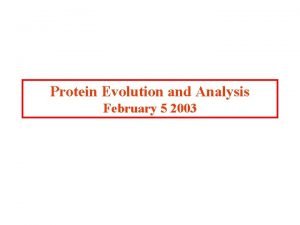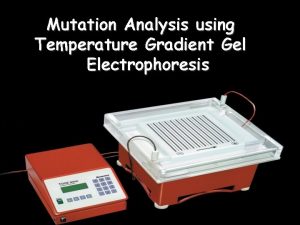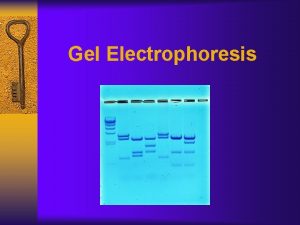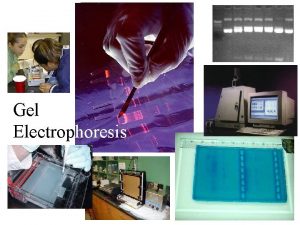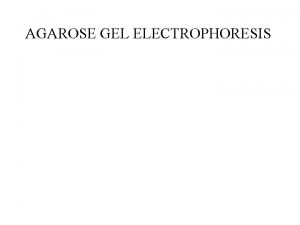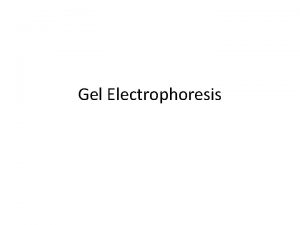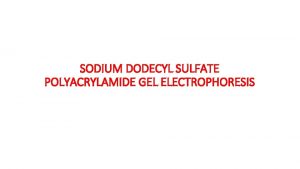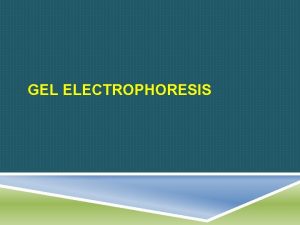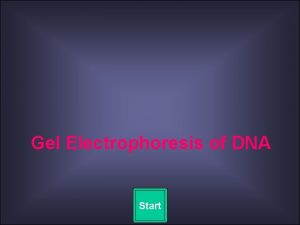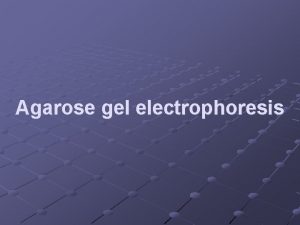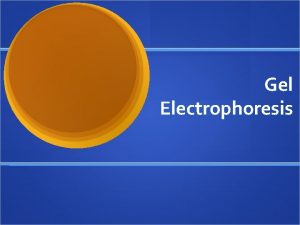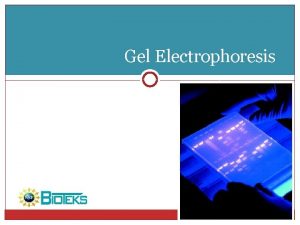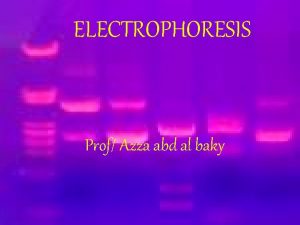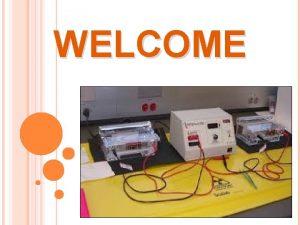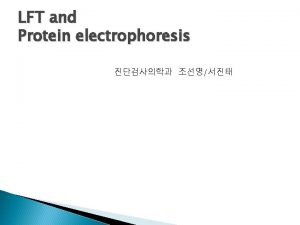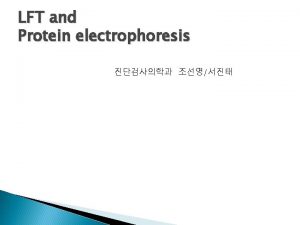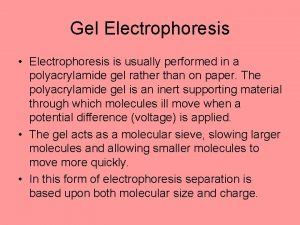Electrophoresis and 2 D Gel Analysis What is











![Components of SDS PAGE Gel B-Mercaptoethanol /DTT [a reducer] Added to prevent oxidation of Components of SDS PAGE Gel B-Mercaptoethanol /DTT [a reducer] Added to prevent oxidation of](https://slidetodoc.com/presentation_image/28a4b40f819b7168e2a3c9c3fde0ce2c/image-12.jpg)

![Polyacrylamide Chemistry Acrylamide monomer N, N'-methylene-bis-acrylamide Tetramethylene diamine [TEMED] Catalyst {O 2 Scavenger} Ammonium Polyacrylamide Chemistry Acrylamide monomer N, N'-methylene-bis-acrylamide Tetramethylene diamine [TEMED] Catalyst {O 2 Scavenger} Ammonium](https://slidetodoc.com/presentation_image/28a4b40f819b7168e2a3c9c3fde0ce2c/image-14.jpg)




















![Differential 2 D Gel Electrophoresis [DIGE] Allows you to mix samples and run a Differential 2 D Gel Electrophoresis [DIGE] Allows you to mix samples and run a](https://slidetodoc.com/presentation_image/28a4b40f819b7168e2a3c9c3fde0ce2c/image-35.jpg)

- Slides: 36

Electrophoresis and 2 D Gel Analysis

What is Electrophoresis ? The migration of a charged particle (protein) through a separation matrix toward the opposite charged electrode Anion Cathode Anode

Types of Electrophoresis 1 D Gel Electrophoresis- DNA, RNA, and Protein Agarose –low resolution, general use for RNA and DNA Polyacrylamide – High resolution Size determination, DNA Sequencing, gel shift, etc SDS-PAGE-Protein Pulse Field- DNA separation of very large fragments of genomic DNA 2 D Gel Electrophoresis Isoelectric focus and PAGE –Protein DIGE-Differential gel electrophoresis Two samples labeled with different fluorophores are mixed and run on a single 2 d gel Capillary Electrophoresis (CE) Linearized polyacrylamide, PVP Automated DNA Sequencing, genotyping Micro-channel/ Micro-fluidic Electrophoresis Lab-on-a-Chip

Electrophoresis and Biomolecules DNA and RNA: Phosphate backbone is negatively charged (anionic) and moves toward positive charge (anode) (-) (-) Separated based on size and sometimes structure slower migration faster migration (-)

Electrophoresis and Biomolecules Proteins: Proteins can have both positive and negative charges Proteins can be acidics or basic [amphoteric] In their native state, the overall charge is variable Anionic detergents [SDS] denature secondary and non–disulfide–linked tertiary structures and impart a negative charge in proportion to its mass. SDS is therefore required when running standard gels to determine size in KDa

R-Groups and Interactions

Electrophoresis and Biomolecules Proteins: Isoelectric Point (IEP)- also known as p. I p. H at which a protein has a neutral charge loss or gain of protons H+ in a p. H gradient That is to say… In a p. H below their p. I, proteins carry a net positive charge and for in a p. H above their p. I, they carry a net negative charge.

Proteins: Isoelectric Focusing (IEF): “First Dimension” in 2 -D gel IEF apparatus from Bio-Rad Utilizes a special p. H gradient strip and high voltage electrophoretic equipment Variable p. H Ampholytes embedded in Acrylamide Proteins separate of according to their isoelectric point (p. I) The equilibrium that a protein establishes at a specific p. H on the IPG is an electro-chemical “focusing”. When a protein moves away from its IEF p. H, its charge will deviate from a neutral state and either gain charge or lose charge and finding its way back to the “comfortable” state of neutral.

1 D Gel Electrophoresis

1 D Gel Electrophoresis-SDS PAGE Standard use for protein separation based on size (MW) Uses sodium dodecyl sulfate to denature protein and provide negative charge for mobility Without SDS, different proteins with similar molecular weights would migrate differently due to differences in mass charge ratio and structure Degree of resolution determined by % acrylamide

SDS PAGE Principles _ SO 4 Na + Sodium Dodecyl Sulfate C A T H O D E _ _ _ _ _ _ _ _ _ + + + + A N O D E
![Components of SDS PAGE Gel BMercaptoethanol DTT a reducer Added to prevent oxidation of Components of SDS PAGE Gel B-Mercaptoethanol /DTT [a reducer] Added to prevent oxidation of](https://slidetodoc.com/presentation_image/28a4b40f819b7168e2a3c9c3fde0ce2c/image-12.jpg)
Components of SDS PAGE Gel B-Mercaptoethanol /DTT [a reducer] Added to prevent oxidation of cysteines and to break up disulfide bonds within the proteins Sodium dodecyl sulfate [negatively-charged ionic detergent] binds to the vast majority of proteins at a constant ratio of 1. 4 gm SDS/gm protein and provide a constant charge to mass ratio for electro-mobility Glycerol Provides density for gel loading Bromophenyl blue A tracking dye used for visualization purposes during a run

Components of SDS PAGE Gel Stacking Gel Is prepared w/Tris/HCL buffer p. H 6. 8, ~2 p. H units lower than running buffer. Large pore polyacrylamide used to align and create a thin starting zone of the protein of apx. 19 um on top of the resolving gel. Resolving Gel Small pore polyacrylamide gel (3 30% acrylamide monomer) typically made using a p. H 8. 8 Tris/HCl buffer. Resolves protein ~24 – 205 k. Da Running Buffer Tris/Glycine: Glycine(p. Ka=9. 69) is a trailing ion (or slow ion). In other words it runs through the gel slower then the slowest protein at a p. H above 8. 0.
![Polyacrylamide Chemistry Acrylamide monomer N Nmethylenebisacrylamide Tetramethylene diamine TEMED Catalyst O 2 Scavenger Ammonium Polyacrylamide Chemistry Acrylamide monomer N, N'-methylene-bis-acrylamide Tetramethylene diamine [TEMED] Catalyst {O 2 Scavenger} Ammonium](https://slidetodoc.com/presentation_image/28a4b40f819b7168e2a3c9c3fde0ce2c/image-14.jpg)
Polyacrylamide Chemistry Acrylamide monomer N, N'-methylene-bis-acrylamide Tetramethylene diamine [TEMED] Catalyst {O 2 Scavenger} Ammonium persulfate {Free radical generator} Polyacrylamide Pore size of gel is determined by total amount of acrylamide and bisacrylamide TEM image

Affect of % Acrylamide 200 200 45 45 45 200 45 6. 5 45

Staining Polyacrylamide Gels Coomassie Blue Stain- can usually detect a 10 -50 ng protein per band Blue Safe Stains -Similar to Coomassie. Destaining optional or water rinse. (8 ng/band) Bio. Safe Blue Simply. Blue Gel. Code Instant. Blue-destaining not recommended Silver Staining- 50 times more sensitive than Coomassie Blue. (0. 3 ng/BAND) Fixation [Acetic acid-methanol] Sensitize gel with sodium thiosulfate Stain with silver solution Rinse with water Develop with formaldehyde and carbonate followed by stopping with Glacial acetic Fluoresecnt Stains –almost as sensitive as Silver but requires excitation source Flamingo Fluorescent Gel Stain Deep Purple* Total Protein Stain SYPRO* Ruby Protein Gel Stain Krypton Protein Stain IR stains

Coomassie –Protein Binding Sulfonic acid group interacts with positively charged amine R groups Basic amino acids including arginine, lysine and histidine but weakly with histidine, tyrosine, tryptophan and phenylalanine Interactions in its anionic form [-] Electrostatic Ionic Van der Waals Hydrophobic

Destaining Gels Most gels require destaining to see banding and to eliminate background stain for high resolution. Gels with abundant protein need not be destained when using certain Safe. Blue stains such as Instant. Blue Coomassie blue destaining Usually requires acetic acid , methanol, and water Safe Blue destaining Usually requires water rinse Silver Stains Some methods use Potassium Ferricynide -Sodium Thiosulfate solutions Some methods use Sodium chloride -Cupric sulfate -Sodium thiosulfate pentahydrate. Some destaining may require a stop solution including 10% Acetic acid

2 D Gel Electrophoresis

2 D Gel Electrophoresis Yeast Proteome: 50 ug protein loaded, p. H 4 -8 ampholines, 10% slab gel, silver stain.

2 D Gel Electrophoresis Separation of hundreds of proteins based on -p. I -MW Up to 10, 000 proteins can be seen using optimized protocols

Why 2 D Gels Oldest method for large scale protein separation (since 1975) Popular method for protein display and proteomics-one spot at a time Can be used in conjunction with Mass Spec Permits simultaneous detection, display, purification, identification, quantification, p. I, and MW. Robust, reproducible, simple, cost effective, scalable Provides differential quantification using Differential 2 D Gel Electrophoresis (DIGE)

Processes involved in 2 D gel electrophoresis Protein isolation and quantification Isoelectric focusing (first dimension) SDS-PAGE (second dimension) Visualization of proteins spots with Dye Identification of protein spots with Mass Spec Bioinformatics

Sample Preparation • Sample preparation is key to successful 2 D gel experiments • Must select appropriate method to get selected proteins from cellular compartment of interest • Membrane proteins, nuclear proteins, and mitochodrial proteins require special steps • Must break all non-covalent protein-protein, protein-DNA, protein-lipid interactions, disrupt S-S bonds • Must prevent proteolysis, accidental phosphorylation, oxidation, cleavage, ect. . • Must remove substances that might interfere with separation process such as salts, polar detergents (SDS), lipids, polysaccharides, nucleic acids • Must try to keep proteins soluble during both phases of electrophoresis process • Must quantify protein

Protein Solubilization 2 -20 m. M Tris base (Carrier ampholytic buffer) 5 -20 m. M DTT (to reduce disulfide bonds) 8 M Urea (neutral chaotrope) Increases the solubility of some proteins Chaotropic agents interfere with stabilizing non-covalent forces (hydrogen bonds, van der Waals forces, and hydrophobic) 4% CHAPS Detergent (3 -[(3 -Cholamidopropyl)dimethylammonio]-1 -propanesulfonate) p. H of 5 -7 Zwitterionic detergent (electronically neutral-has a both Neg and Pos useful for varible charged peptides ) Protects the native state of proteins Better when downstream apps include IEF because no affect on p. H gradients

IEF and IPG (immobilized p. H Gradient) Strip of paper Made by covalently integrating acrylamide and variable p. H ampholytes Separation on basis of p. I, not MW Available in different p. H ranges 3 -10 4 -8 5 -7 Requires very high voltages (5000 V)and long period of time (10 h) p. H 3 4 5 6 7 8 9 10

I IPG Strips Contain Ampholytes are molecules that contain both acidic and basic groups Protein will migrate in the Matrix and will find their p. H equilibrium (p. I)

The Second Dimension …Running the Gel

SDS Gel p. H Similar p. I but different mw 3 Negative electrode 4 5 6 7 8 Positive electrode 9 10 IPG strippressed down into the SDSPAGE gel Similar mw but different p. I

Different IPG p. H ranges yield Different Results p. H 4 p. H 5 p. H 7 p. H 9

Gel Stains - Summary Stain Sensitivity (ng/spot) Advantages Coomassie-type 5 -10 Simple, fast Silver stain 1 -4 Very sensitive, laborious Copper stain 5 -15 Reversible, 1 reagent negative stain Zinc stain 5 -15 Reversible, simple, fast high contrast neg. stain SYPRO ruby 1 -10 Very sensitive, fluorescent

2 D Gel Results • 401 spots (peptides or PTM) identified • 279 gene products

2 D Gel Post Analysis Compare gel images and determine what bands/spots are different Requires software to compare gels Apparent difference. Need to extract spot for MS

Extracting a Gel Spot Cut out spot Trypsin Digestion of Gel spot Run Mass spec
![Differential 2 D Gel Electrophoresis DIGE Allows you to mix samples and run a Differential 2 D Gel Electrophoresis [DIGE] Allows you to mix samples and run a](https://slidetodoc.com/presentation_image/28a4b40f819b7168e2a3c9c3fde0ce2c/image-35.jpg)
Differential 2 D Gel Electrophoresis [DIGE] Allows you to mix samples and run a single 2 d gel for comparative and quantitative purposes Fluorescent stain Cy 3 -- Normal liver Cy 5 --Tumor Both

Conclusions • 2 D gel electrophoresis is a popular method for protein display, separation, visualization, and quantitation • A good precursor to MS, but not required • 2 D gels provide p. I, MW data, and photodocumentation • Web tools are now available that permit partial analysis and comparison of 2 D gels using software and simulators • 2 D gels are fun to run
 Paper and gel electrophoresis
Paper and gel electrophoresis Process of gel electrophoresis
Process of gel electrophoresis Translate image
Translate image Restriction enzymes gel electrophoresis
Restriction enzymes gel electrophoresis Electrolysis gel
Electrolysis gel Gel electrophoresis separates dna by
Gel electrophoresis separates dna by Gel electrophoresis advantages
Gel electrophoresis advantages Gel electrophoresis separates dna by
Gel electrophoresis separates dna by Agarose gel electrophoresis vs sds page
Agarose gel electrophoresis vs sds page How to use the micropipette
How to use the micropipette Electrophoresis lab ap bio
Electrophoresis lab ap bio Zone electrophoresis definition
Zone electrophoresis definition Is gel electrophoresis a biotechnology
Is gel electrophoresis a biotechnology Electrophoresis definition
Electrophoresis definition Gel electrophoresis result
Gel electrophoresis result Disadvantages of agarose gel electrophoresis
Disadvantages of agarose gel electrophoresis Procedure of sds page
Procedure of sds page Polyacrylamide gel electrophoresis (page)
Polyacrylamide gel electrophoresis (page) Gel electrophoresis cathode anode
Gel electrophoresis cathode anode Agarose gel vs polyacrylamide gel
Agarose gel vs polyacrylamide gel Gel kim olursan ol yine gel
Gel kim olursan ol yine gel Laser doppler electrophoresis
Laser doppler electrophoresis Protein electrophoresis interpretation
Protein electrophoresis interpretation Automated+electrophoresis+system
Automated+electrophoresis+system Zonal electrophoresis
Zonal electrophoresis Electrophoresis in colloidal solution
Electrophoresis in colloidal solution Thalassemia
Thalassemia Capillary electrophoresis disadvantages
Capillary electrophoresis disadvantages Sickle cell anemia symptoms
Sickle cell anemia symptoms Hemoglobin electrophoresis
Hemoglobin electrophoresis Hemoglobin electrophoresis
Hemoglobin electrophoresis Types of sickle cell disease
Types of sickle cell disease Electrophoresis
Electrophoresis Paper electrophoresis
Paper electrophoresis Electrophoresis
Electrophoresis Paper electrophoresis
Paper electrophoresis Instrumentation of electrophoresis
Instrumentation of electrophoresis
